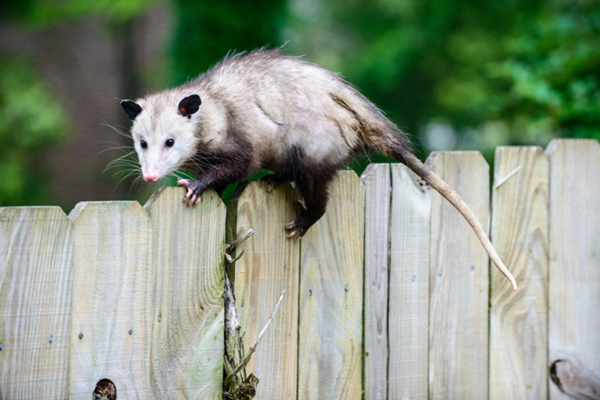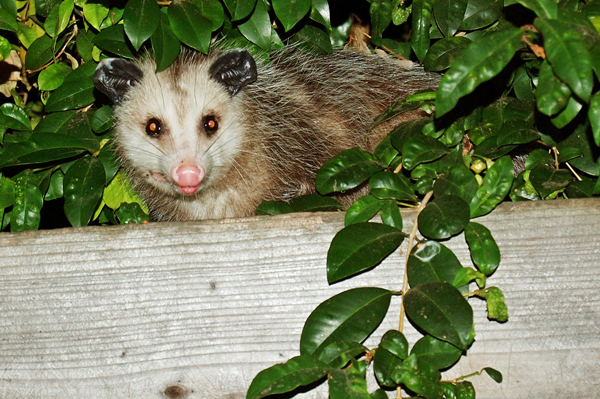- Details
- Category: Case Studies
State wildlife agencies, under the auspices of the International Association of Fish and Wildlife Agencies, are developing "Best Management Practices" (BMPs) for trapping furbearers in the United States as a way to evaluate and improve animal welfare, identify efficient tools and techniques, and develop recommendations for conservation professionals to consider as an element of their wildlife management programs. Regulated trapping is a necessary and effective wildlife management tool, and wildlife professionals across the country believe that trapping BMPs will ensure the continued improvement of this management technique.
Biologists began the process of developing trapping BMPs by reviewing past scientific literature to determine what research had already been done and to develop priorities for the program. The trap testing needs for twenty-three species of furbearers were assessed. Criteria considered for species prioritization included: 1) the type and proportion of trapping systems predominantly used; 2) the total harvest in this country; 3) the importance to the trapper; 4) the amount and type of economic damage caused; 5) the urgency and opportunity for additional work from the biologists' perspective; and 6) the availability and quality of data from past research programs.
Traps are selected for evaluation by state wildlife agency biologists based on their knowledge of the technique and using data from a survey conducted by IAFWA in 1992 that documents the ownership and use of traps by trappers in the United States. We also invite trappers to recommend traps and modifications for evaluation. Trappers are often aware of new models on the market, many of which are specifically intended to improve animal welfare and may not be widely available but are promising designs for trapping BMPs. Scientists from the USDA National Wildlife Research Center are also involved with this program.
Projects investigating the performance of various capture devices in field settings began in the fall of 1997. The field projects are conducted by licensed, experienced trappers during state-regulated trapping seasons. Trained technicians are assigned to accompany each trapper and record trap line data under guidance of state agency biologists and IAFWA staff. All trappers and technicians must attend mandatory training sessions and abide by clearly defined study procedures.
Two veterinary laboratories in the U.S. with extensive experience in evaluating capture devices conduct full-body necropsies in order to discover which of the restraining traps do the best job of reducing injuries to animals. The data collected from the veterinarians and from the field-work are consistent with international standards for trap evaluation.
Canada is also conducting trap evaluations and we are working cooperatively with them to share information. Much of the research into humane killing traps has been conducted at a uniquely equipped, state-of-the-art Canadian research facility. BMPs will include recommendations for the use of humane killing traps for those species and under those conditions where reasonable and prudent.
Results from these projects will be used in conjunction with existing data to develop trapping BMPs based on performance criteria for animal welfare, efficiency, selectivity, safety and practicality.
- Details
- Category: Case Studies
The Case of Nutria (Myocastor coypus) in Louisiana
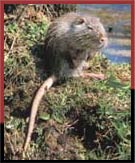
Nutria (Myocastor coypus)
Louisiana’s marshes are under siege from a 12-pound rodent with a huge appetite. The Mississippi River delta’s marshes are the largest wetland complex in the United States and are literally being eaten away by an animal called nutria.
At first glance, nutria seem innocuous. These semi-aquatic rodents have glistening fur and are a little smaller than a beaver. Sometimes they may even be mistaken for beaver as the glide along with their heads barely above the water’s surface. They are agile swimmers. Yet despite all appearances, nutria are a big problem around the world and especially in Louisiana.
Native to coastal and lake marshes of Argentina, they seem to live in harmony with their environment. Their population levels fluctuate with periods of drought and flood. However, they are adapted to quickly repopulate their habitats following a natural disaster. What happens, though, when nutria populate an area that does not have frequent cycles of flood and drought? In many cases, nutria can cause significant environmental and economic problems.
In Louisiana, nutria inhabit the freshwater and partly salty, brackish, marshes along the Mississippi River delta. Like all wetlands, these marshes are incredibly productive and critical to the life cycle of innumerable species.
15 million water birds, 5 million wintering waterfowl, more than a million alligators, and 11 threatened and endangered species; Nearly every commercially important fishery in the Gulf of Mexico is linked to this wetland complex including shrimp and crabs.
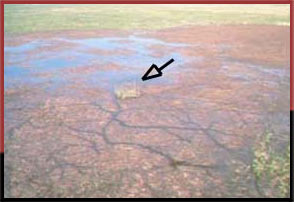
This aerial photograph shows an "eat out." The brown areas of the marsh have been damaged by nutria. In the center, as indicated by the arrow, is an area that has been fenced off to exclude the nutria.
Nutria are a significant threat to this ecosystem because they reproduce very quickly and when they feed in an area they may eat the vegetation to the roots exposing the fragile wetland soils, and they are born as eating machines, virtually miniature versions of an adult, ready to feed within hours of birth. As tides ebb and wane, the flowing water erodes the soils where the nutria have eaten away the grasses, and the soils are pulled into the Gulf of Mexico. Once the soils are gone, the plants cannot re-grow.
Captive nutria were first introduced to the marshes of Louisiana in 1937 when 13 escaped from a captive nutria colony owned by L.E. McIlhenny, a renowned conservationist and founder of the Tabasco Company. In 1940 approximately 150 more nutria escaped captivity during a hurricane. McIlhenny was reportedly sad at his loss because he believed that the nutria would perish as prey to the alligators, but the nutria proved him wrong.
What McIlhenny did not take into account was the amazing reproductive abilities of the nutria. They are prolific animals. Typically, nutria begin to reproduce when they are between four to six months old, and they have more than two litters each year. With typical nutria litters exceeding four young, each female nutria may have an average of more than 10 young annually.
By 1956, nutria harvest reached 419,000, this in less than 20 years since nutria were first introduced to Louisiana, and the nutria populations were continuing to grow. Farmers were complaining about nutria damage to rice and sugarcane fields, and muskrat trappers worried that nutria were responsible for declining muskrat populations.
In the early 1960s Louisiana Department of Wildlife and Fisheries needed to find a solution to the crop and habitat problems caused by nutria. Because nutria populations grew faster than the predators could eat the nutria, they felt that encouraging trapping was the best alternative to solving nutria problems. Trappers however, are motivated by the price of fur - the more the fur was worth the more trappers would pursue nutria. The LDWF set out to create a market for nutria.
By 1962 LDWF had established a market when more than a million nutria pelts were sold into the German fur trade. As prices for nutria fur continued to rise through the 1970’s, trappers continued to trap nutria, averaging 1.5 million pelts a year and generating an average 8.1 million dollars annually.
From the early 1960s until the early 1980s high fur prices were the driving force behind high harvest levels. Throughout this period, nutria problems were virtually nonexistent. There were very few crop damage reports and the nutria were not significantly harming the wetland habitats.
Everything changed during the 1981-82 trapping season. Prices for nutria fur fell by nearly half from $8.19 to $4.36. By the end of 1993, the market bottomed at only $2.64 for each pelt. Trappers lost their incentive to pursue nutria, and the mid-1980s harvest declined to less than 300,000.
Nutria populations exploded without the trapping pressure. Following 28 years of profitable trapping and few complaints from the agricultural community, 1987 marked renewed concern over nutria damage as farmers again experienced crop losses. Scientists became alarmed by the wetland habitat problems caused by nutria.
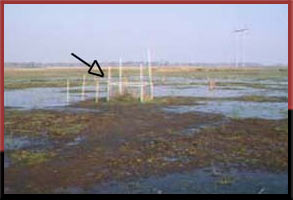
A closer look at the fenced area shows the plants are much taller and healthier inside, away from the nutria.
In 1993 scientists began to survey the damage that nutria were causing to Louisiana wetlands. By flying over the wetlands, the scientists could measure the land area (acreage) of nutria damage. By 1998 scientists estimated the damaged wetlands exceeded 100,000 acres in Louisiana. More alarming is that this estimate is probably only a fraction of the actual area impacted by nutria because only the most affected areas are detected during the surveys.
Louisiana’s marshes cover more than 2.5 million acres, an area larger than Yellowstone National Park. Historically, trappers and their families disperse into the marsh for months at a time in search of nutria, and there may be thousands of trappers covering the expansive marsh complex when fur prices are high. When fur prices are low, trappers cannot make enough money to justify the difficulties of trapping the extensive Louisiana marshlands.
Biologist Greg Linscombe of the LDWF says that when nutria harvest exceeded one million animals per year, habitat and crop damage were eliminated. However, trappers will not seek nutria unless they can make a profit.
Low fur prices necessitate an alternative market. The LDWF hopes that nutria will be valued for their meat as well as fur. As the market for nutria meat grows trappers will again seek nutria, and as harvest increases wildlife biologists expect that habitat and crop damage will decrease.
In 1986 the Louisiana Legislature created the Louisiana Fur and Alligator Advisory Council, and this group continues to work on creating and enhancing international markets for Louisiana nutria fur and meat. By enhancing the markets, they hope that they can increase the trappers’ profits.
The Advisory Council has spent more than 800,000 dollars using funds from trappers’ licenses and other sources to work on the market enhancement activities. Harvest rates are now the highest since 1989 with the annual harvest in excess of 350,000 nutria. But this still falls short of the million animals that must be harvested to eliminate habitat and crop damage.
Trapping nutria is vital to protecting Louisiana wetlands. It is the only protection for a river of life that flows from the Mississippi delta to the Gulf of Mexico.
- Details
- Category: Case Studies
The Story of the North American River Otter (Lutra canadensis)
 The River Otter! What an interesting animal. No wonder they are the center of so much attention. Otters were largely absent from a big part of mid-America by the 1900s, due to more than 200 years of unregulated harvest and habitat changes. Thanks to a partnership between trappers and wildlife managers, we can once again kiss these babies hello, because we are in the middle of an unbelievable river otter comeback! Nearly 4,000 healthy otters have been trapped and moved to new homes in 18 states in one of the most successful predator restoration programs ever.
The River Otter! What an interesting animal. No wonder they are the center of so much attention. Otters were largely absent from a big part of mid-America by the 1900s, due to more than 200 years of unregulated harvest and habitat changes. Thanks to a partnership between trappers and wildlife managers, we can once again kiss these babies hello, because we are in the middle of an unbelievable river otter comeback! Nearly 4,000 healthy otters have been trapped and moved to new homes in 18 states in one of the most successful predator restoration programs ever.
Sixty years after most state agencies began the art and science of modern wildlife management, the long list of wildlife restoration success stories now includes river otters. The task began back in 1976 when Colorado biologists moved a few wild-trapped otters from Minnesota. Then they discovered a Cajun from Louisiana named Lee Roy Sevin and his wife Diane. The Sevins have an unusual business – buying live river otters caught with foothold traps in the surrounding marshes, where otters are abundant. They keep the pregnant females in captivity just long enough for them to give birth to a litter of pups in the spring, and then release the adults back into the marsh while hand-rearing the otter pups for zoos.
Beginning in the 1980's, wildlife managers set plans in motion to bring the adult, wild-trapped otters to Missouri, Iowa, Illinois, and other states where otters once existed, to be released into new homes to restore populations. The first releases included otters with radio transmitters that allowed us to monitor their success in their new homes. They did extremely well, and we set about our business to restore otters throughout the waterways of the Midwest, the Northeast, and the Mid-Atlantic states. Not all otters used in the restoration efforts came from Louisiana; many eastern states are trapping and moving their own otters from areas where they occur to areas where they are absent. However, thanks to their efforts, Lee Roy and Diane are known as the Godparents of otter restoration in the United States, having shipped more than 2,400 otters to different states for restoration programs!
In almost every state, even dusty Arizona, these programs have met with tremendous success, and have been wildly popular with the public. As an example, Missouri’s otter population is now estimated at more than 8,500 and growing, and a carefully regulated trapping season is now possible. Tennessee, Kentucky, Iowa, and other states with large otter restoration projects consider them to have been huge successes and otters are no longer endangered in most of these states. For the remainder of the states, success stories are just a matter of time.
River otters are not federally endangered, although in a handful of states they may still have a state-endangered status until the restoration programs are complete. One confusing aspect of the river otter’s status stems from its listing on the Convention for International Trade of Endangered Species, known as CITES. This treaty listed North American river otters on Appendix II simply because they look somewhat like otters from other continents that may be endangered. Pelts of abundant river otters could become confused with pelts of endangered otters from other continents if trade was not carefully regulated. So we tag every single otter from the United States that enters the international fur trade with a small CITES export tag, and that helps to ensure protection for other otters around the world. A CITES tag on fur pelts traded internationally indicates that the pelt comes from animals whose populations are not endangered, but are abundant and being carefully monitored and scientifically managed. Properly regulated trapping seasons such as we have now in 29 states are no threat to river otter populations. Otter populations are believed to be either growing or stable in 46 out of the 47 states where they are currently known to exist!
Importantly, virtually every otter used in these restoration programs was captured in the wild by people using foothold traps. These animals had to be healthy to have led to the successes we’ve witnessed. These are the same traps used by licensed trappers to capture wildlife!
- Details
- Category: Case Studies
The Prohibition of Regulated Trapping Beaver activity washed out this road.
 Chelmsford, Massachusetts is located about 20 miles northwest of the city of Boston and encompasses approximately 23 square miles. The first European settlement in the area was a fur trading post, established due to the abundance of beaver in the local wetlands. Today there are still approximately 870 acres of wetlands within the town, but it is now a densely settled suburban community with over 32,000 residents (1,357 per square mile). Local government is conducted through open town meetings and administered by five elected selectmen.
Chelmsford, Massachusetts is located about 20 miles northwest of the city of Boston and encompasses approximately 23 square miles. The first European settlement in the area was a fur trading post, established due to the abundance of beaver in the local wetlands. Today there are still approximately 870 acres of wetlands within the town, but it is now a densely settled suburban community with over 32,000 residents (1,357 per square mile). Local government is conducted through open town meetings and administered by five elected selectmen.
During the late 1980s, a national animal rights group developed a "model" for getting trapping ban initiatives passed by town, county and sate governments. The model guidelines encouraged animal rights activists to disguise regulated trapping as a public safety/animal welfare issue. Exactly in accordance with such direction, an article to ban trapping was introduced at a Chelmsford town meeting in 1988.
State wildlife experts reminded residents that regulated trapping was not a public safety issue, and warned that if regulated trapping were banned, there would be numerous undesirable consequences in the form of property damage and wildlife habitat degradation. Despite the warnings, the article was passed, and the trapping of furbearing mammals within the town was prohibited.
Prior to passage of the trapping ban, there were usually one to three complaints of beaver damage in the town each year. Following the ban, the beaver population, unchecked, began to grow rapidly, and the animals began to move into many previously unoccupied wetlands. Beaver dams began to flood houses and roadways. In 1992, state wildlife biologists working at the request of town officials investigated 25 beaver complaint sites. Two of these complaint sites were municipal wells which had been shut down (at a cost of $25,000) because of beaver flooding, and four other municipal wells were threatened. Individual landowners in town had incurred tens of thousands of dollars in damages to private wells, septic systems, lawns and roadways. The increasing beaver population and increasing property damage were directly related to the decision of the town's citizens to ban regulated trapping and allow uncontrolled beaver population growth to commence.
State wildlife officials offered the town several recommendations: (1) use water flow devices to reduce flooding in some areas, (2) get permits to breach beaver dams in other locations, and (3) rescind the trapping ban bylaw to allow beaver populations to be brought under control. The town took positive steps to implement these recommendations. The state issued permits to breach beaver dams that were disabling wells and septic systems. State wildlife personnel installed water flow devices (beaver pipes) at two sites and assisted town water department personnel with a third pipe. At a special town meeting in September, 1992, town citizens voted by a two-to-one margin to allow regulated public trapping to resume. During the regular trapping season later that fall and winter, four fur harvesters working with homeowners and town officials removed 87 beaver. Today, with public, regulated trapping restored, Chelmsford again has only one to three beaver complaints per year. These are handled as they had been prior to 1988, under an effective and responsible program incorporating state wildlife officials and local fur harvesters.
In Massachusetts, the state wildlife agency has a well developed management plan for beaver. The goals of this plan are to manage beaver resources as assets, not liabilities; perpetuate beaver populations for future generations; keep the beaver population at levels compatible with suitable habitat; minimize property damage caused by beaver; manage beaver for their positive wetland values, and allow people the sustainable use of public resources.
Chelmsford residents were confounded by animal rights activists who had promised in 1988 and again in 1992 to install water flow devices and proposed to "sterilize" beaver in the town (a technique that is not feasible on a free-roaming beaver population,) Over the four years of the trapping ban, the activists never acted on their promises and were never held accountable for the statements they put forth.
The case study you just read was written several years ago. Recently, the state of Massachusetts passed a ballot initiative that severely restricts trapping. As a result, complaints about property damage and health concerns related to beaver activity have dramatically increased. We have asked a biologist from the Massachusetts Department of Fish and Wildlife to give us an update about the situation.
Epilogue - A State Ballot Referendum
Submitted by Susan Langlois – Massachusetts Division of Fisheries and Wildlife
7 July 1999
Subsequent to the town of Chelmsford reinstating regulated trapping as a management tool to control the beaver population, changes to Massachusetts state law ensued during the November 5, 1996 election. A major political ad campaign was undertaken by several animal rights organizations which spent $1.2 million in a statewide ballot referendum. As a result, a statewide change to Massachusetts law created restrictions similar to the Chelmsford anti- trapping bylaw. The new law dramatically changed the types of traps that licensed trappers could lawfully use to control beaver populations statewide.
The net effect of the new law maximizes the number of beavers found in Massachusetts. A maximized beaver population significantly increases property damage, health and safety issues and other beaver related problems incurred by citizens. Now the same conditions that were evident in Chelmsford during their trapping ban have expanded throughout the state. The statewide beaver population has grown significantly from an estimated 24,000 in 1996 to more than 52,000 in 1999. Citizen complaints related to beaver activity continue to increase from an average of 310 per year (1991-96) to 585 per year since the law came into effect.
Beaver populations can no longer be maintained at reduced levels. This constitutes a major change in the way beaver are managed. The state’s beaver management program has historically been proactive – maintaining the beaver population at levels compatible with suitable wetland habitat and human needs. The new law eliminates proactive, regulated management, yielding an uncontrolled expansion of the beaver population. Like the previous Chelmsford bylaw, it only allows the citizens of Massachusetts to take reactive measures to beaver causing property damage. Instead of viewing beaver as valuable wildlife, more and more people are viewing beaver as a pest to be eliminated.
Due to the increase in the beaver population and the related increase in health and safety concerns and property damage, two bills have been introduced into the Massachusetts Legislature to repeal or significantly amend the existing statewide law. In addition, legislation has been submitted to appropriate $1.5 million to begin to pay for the property damage caused by increasing beaver populations. The appropriation of monies was not needed in the past when proactive management programs employed regulated trapping to control beaver populations and address property damage problems. To date, the statewide ban on traps continues.
Royal Pest Services
-
Mosquito Control Solutions for Jacksonville Summers
Summers in Jacksonville are made for backyard
... -
How to Spot and Prevent a Termite Infestation
Termites are more than just a
... -
The Top 5 Pests to Watch Out for This Spring
As temperatures rise in Jacksonville, so does
... -
Fertilization 101: Growing a Lush Lawn in Jacksonville
A lush, vibrant lawn is a source of pride for
... -
Jacksonvilleâs Spring Lawn Care Checklist: Healthy Grass & Pest Control Tips
As winter fades and temperatures rise,
...


